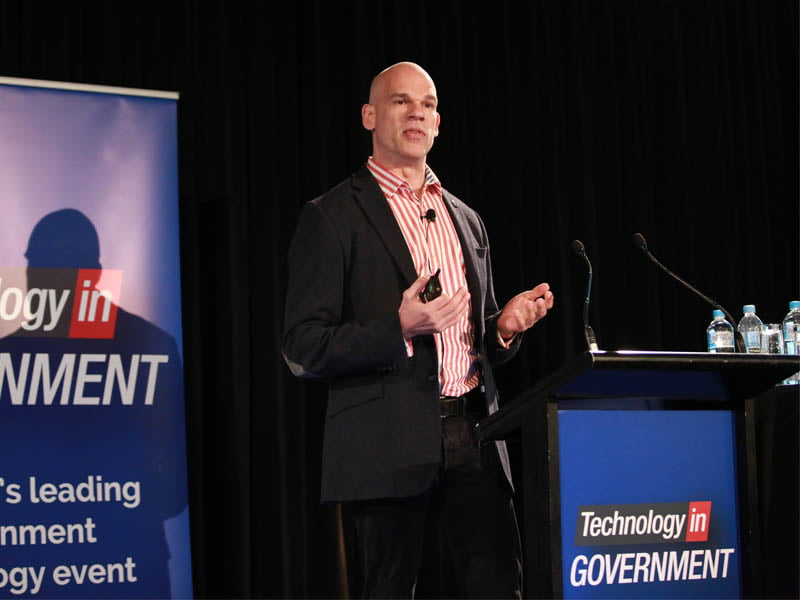The Australian Public Service should be readying itself for a radical shake-up, if the directions taken in the UK and the US are anything to go by. It is going to be a wild ride.
There are different views between digital transformation leaders about the best way to reach the Promised Land of excellent low-cost government services and ubiquitously happy citizens. But it’s not called a ‘transformation’ for nothing – and inert power structures are about to come under pressure to change.
Speaking at the Technology in Government conference in Canberra, the Chief Technology Officer of the UK Cabinet Office James Duncan says the delivery of government services requires an entirely new kind of leadership within the public sector.

Even the philosophical concept of what ‘leadership’ means in government needs to change, Mr Duncan said.
The departmental structures of government in the UK had created the same kind of silos of data and silos of services that are found in Australia.
“Departments are sovereign, they are their own fiefdoms,” Mr Duncan. “And that sort of sovereignty has lasted over 200 years, but it’s not really relevant in a world where information exchange is so simple but where just getting departments to trust each other, to talk to each other, to share information and build services requires such a fundamental shift in thinking.”
“It requires a different set of leaders and a different view of what leadership is,” he said.
A part of the UK GDS program is around getting agencies talking to each other, and ultimately creating services that are whole of government.
For former US government Chief Technology Officer Aneesh Chopra, the aim should be less about giving government a single view of the user, as giving the citizen a single view of the government – albeit through a choice of different channels.
Mr Chopra says there had long been a dream in government of getting agencies to work together, and that he had been tasked with creating a technical framework – a standards-based framework that would allow that to happen
“The conclusion that I reached was that rather than just having the agencies connect to each other with all kinds of privacy concerns and concerns about the capacity of government to do this – and frankly risk the hundreds of millions and billions of dollars in wasted expenditure when these programs fail – the conclusion that I reached was basically we should enable the consumer to mediate across these silos.
“As annoying as it feels, a consumer-mediated model is a dramatically de-risked model,” he said. Mr Chopra says it makes more sense to open up data sets, and to create government service platform, so that third-parties from the private sector can deliver the “last mile.”
Why shouldn’t a citizen be able to access Social Services through an interaction with Walmart, for example?
Newly-appointed Digital Transformation Office chief executive officer Paul Shetler is happy to refer to citizens as users of government services, not customers. The notion of a ‘customer’ infers choice, where a citizen has none in dealing with government.
This adds an ethical dimension to the provision of government services, he says. “People have no choice but to use our services. And [as government] we have no choice about who our users are. It is therefore an ethical obligation that government provides the best services possible.
The opportunity is immense, he says. “We can have happy citizens. Think about that.”
Public servants had been poorly served by IT infrastructure that had been built to serve the needs of government and the needs of process, rather than focus on its users and service consumers.
“Often public servants have been forced to become ‘human APIs’,” Mr Shetler said, cutting and pasting and manually manipulating different data from different applications.
“If Amazon tried to do business by asking you to print out a PDF, fill it in and post it back so it could be keyed in again, they would not be in business for long,” he said.
Mr Shetler has been in Australia for about a month. But he has been taking opportunities to talk up the Commonwealth’s digital transformation agenda. Everything is about change. And change is difficult when trust is in short supply.
He says a shocking track record of technology support and delivery has created trust deficit inside the public service anywhere where technology project are involved. Inflexible systems, late delivery, poor services have accumulated.
“We have to get the trust back from our internal users,” he said. The DTO is driving a similar mantra to that used by the Government Digital Service in the UK, and F18 digital delivery engine in the US: Think big, start small. Iterate, iterate.
The DTO says that its strategy is delivery. That is, winning back the trust of its public service users will be through delivery of value. Winning over citizen users will be through delivery. Cultural change will come about through delivery.
“Everybody [in the DTO] is a doer and a maker. We focus on the small things that delivery real value – in human timeframes, not geological time frames,” he said.
“Delivery is capital in government. Every time you deliver something, your capital grows.”
Do you know more? Contact James Riley via Email.

